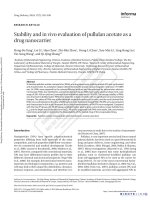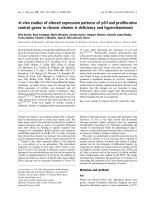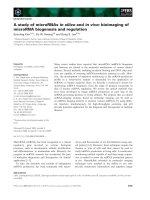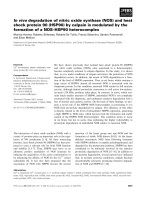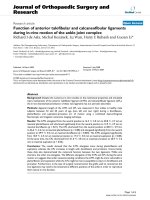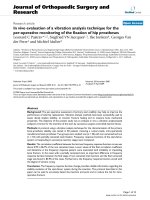In vitro and in vivo evaluation of customized polycaprolactone tricalcium phosphate scaffolds for bone tissue engineering
Bạn đang xem bản rút gọn của tài liệu. Xem và tải ngay bản đầy đủ của tài liệu tại đây (5.53 MB, 143 trang )
IN VITRO AND IN VIVO EVALUATION OF CUSTOMIZED
POLYCAPROLACTONE TRICALCIUM PHOSPHATE SCAFFOLDS
FOR BONE TISSUE ENGINEERING
ERVI SJU
(B.Eng.(Hons.), NUS)
A THESIS SUBMITTED
FOR THE DEGREE OF MASTER OF ENGINEERING
DEPARTMENT OF MECHANICAL ENGINEERING
NATIONAL UNIVERSITY OF SINGAPORE
2010
PREFACE
The thesis is submitted for the degree of Master of Engineering in the Department of
Mechanical Engineering at the National University of Singapore under the
supervision of Professor Teoh Swee Hin and Dr Alvin Yeo. No part of this thesis has
been submitted for other degree at other university or institution. Parts of this thesis
have been published or presented in the following:
INTERNATIONAL JOURNAL PUBLICATION
A. Yeo, E. Sju, B. Rai, S.H. Teoh. Customizing the degradation and load-bearing
profile of 3D polycaprolactone-tricalcium phosphate scaffolds under enzymatic and
hydrolytic conditions. Journal of Biomedical Materials Research Part B: Applied
Biomaterials. (Published online: 10 June 2008).
CONFERENCE PAPERS
E. Sju, A. Yeo, B. Rai, S.H. Teoh. In vitro and in vivo degradation profile of
untreated, sodium hydroxide- and lipase-treated PCL-TCP scaffolds. International
Conference on Advances in Bioresorbable Biomaterials for Tissue Engineering,
Singapore, 2008.
E. Sju, A. Yeo, B. Rai, S.H. Teoh. Enzymatic and hydrolytic degradation of poly(εcaprolactone)
tricalcium
phosphate
composite
scaffolds.
4th
International
Conference on Materials for Advanced Technologies (ICMAT), Singapore, 2007.
i
ACKNOWLEDGEMENTS
The author wishes to express her sincere gratitude and heartfelt appreciation to the
following people who have rendered generous support and technical assistance
leading toward the accomplishment of this project:
Professor Teoh Swee Hin (Department of Mechanical Engineering), supervisor,
for offering the privileged opportunity to work on this project and allowing the
author to join his team, for his expertise, kindness, and most of all, his patience.
His enthusiasm in research and continuous support have truly been a source of
inspiration and motivation for this project throughout.
Dr. Alvin Yeo (Department of Mechanical Engineering and National Dental
Centre), co-supervisor, for his patience and guidance on supervising the author
throughout the whole process. He has been an immense driving force behind this
project. One simply could not wish for a better or friendlier supervisor.
Dr. Bina Rai, mentor, for graciously sharing her knowledge and encouragement
in this project. Her kind assistance and time spent are greatly appreciated.
Dr. Zhang Zhiyong, Ms. Erin Teo Yi Ling and Mr. Mark Chong Seow Khoon,
PhD students, for their constructive feedbacks and for being excellent mentors.
They have gone out of their way to render assistance on many occasions.
Mr. Cheong Jia Jian, NUS alumnus, whom was unreserved in sharing his
knowledge and experience in this research field.
Mdm. Zhong Xiang Li (Materials Science Lab) for the use of the SEM (JEOL
JSM 5600LV) and the gold-sputtering machine.
ii
Dr. Zhang Yanzhong (Biomechanics Lab) and Ms. Eunice Tan Phay Sing
(NanoBiomechanics Lab) for the use of the Instron 3345 compressive
mechanical tester machine.
Dr. Jeremy Teo Choon Meng (DSO National Lab) and Ms. Lei Yang (Biosignal
and Instrumentation Lab) for the use of the Skyscan 1076 Micro-CT.
Dr. Lin Jian Hua and Ms. Juline Sim Siew Hong (PSB corporation) for their
assistance in Gel Permeation Chromatography.
Ms. Irene Kee (SingHealth Experimental Medicine Centre, Singapore General
Hospital) for her assistance in the animal handling and maintenance.
Ms. Han Tok Lin (Faculty of Dentistry, NUS) for her assistance in Histology.
Mr. Jackson Ong Sing Kiat and Dr. Chui Chee Kong (BIOMAT), Mr. Zhang
Jing (Biosignal and Instrumentation Lab), and fellow students at BIOMAT for
their support and encouragement throughout the fulfilling years.
To all, who have given contribution in one way or another.
And to all close friends, for being understanding during this challenging period.
Thank you for always being there during both good and bad times.
Last but not least, the author would like to thank her parents Mr. Sju Tjing
Kwang and Mrs. Tea Giok Tjian, and younger sister Ms. Lydia Sju, for their
constant love and support, without which this study would not have been
possible. Their undaunting confidence gave the author the strength to overcome
any difficulties. To them the author dedicates this thesis.
The author acknowledged the financial support by the following grants:
No. 016/06 from National Dental Centre (SingHealth), Singapore.
TDF/CD003/2006 from SingHealth (Talent Development Fund), Singapore.
iii
TABLE OF CONTENTS
PREFACE
i
ACKNOWLEDGEMENTS
ii
TABLE OF CONTENTS
iv
SUMMARY
ix
LIST OF TABLES
xi
LIST OF FIGURES
xii
LIST OF SYMBOLS
xviii
LIST OF ABBREVIATIONS
xx
CHAPTER 1: INTRODUCTION
1.1 BACKGROUND
1
1.1.1 Bone tissue engineering
1
1.1.2 Application in dentoalveolar defects
3
1.1.3 PCL-TCP scaffolds: Current drawbacks
4
1.2 RESEARCH OBJECTIVES
5
1.3 RESEARCH SCOPE
6
1.3.1 Part 1: Selective modification of PCL-TCP scaffolds
targeted for dentoalveolar reconstruction application
6
1.3.2 Part 2: Optimization of native and customized scaffolds
in vitro and their effects in initial bone healing
6
1.3.3 Part 3: Evaluation of PCL-TCP scaffolds in a clinically
relevant defect model
7
iv
CHAPTER 2: LITERATURE REVIEW
2.1 BONE PHYSIOLOGY
8
2.1.1 Composition
8
2.1.2 Morphology
11
2.2 POLY(ε-CAPROLACTONE)
13
2.2.1 Degradation of PCL polymer
14
2.2.1.1 Hydrolysis mechanism
16
2.2.1.2 Enzymatic degradation
17
2.3 TRICALCIUM PHOSPHATE (TCP)
2.3.1 Degradation mechanisms of calcium phosphate ceramics
18
19
2.3.1.1 Physicochemical degradation
19
2.3.1.2 Cellular degradation
21
2.3.1.3 Mechanical degradation
21
2.4 PCL-TCP SCAFFOLDS
22
2.4.1 Fabrication method of PCL-TCP scaffolds
24
CHAPTER 3: SELECTIVE MODIFICATION OF PCL-TCP SCAFFOLDS TARGETED
FOR DENTOALVEOLAR RECONSTRUCTION APPLICATION
3.1 INTRODUCTION
29
3.2 MATERIALS AND METHODS
30
3.2.1 Scaffold design and fabrication
30
3.2.2 Sterilization of scaffolds
30
3.2.3 Scaffold characterizations
31
3.2.3.1 Micro-computed tomography analysis
31
3.2.3.2 Gravimetric analysis
31
3.2.3.3 Compressive mechanical testing
32
3.2.3.4 Electron microscopy preparation and analysis
32
v
3.2.3.5 Molecular weight testing
3.2.4 Statistical analysis
33
33
3.3 RESULTS
34
3.3.1 Porosity measurements and 3D model analysis
34
3.3.2 Weight loss analysis
36
3.3.3 Compressive mechanical properties
37
3.3.4 Surface morphology analysis
38
3.3.5 Molecular weight analysis
40
3.4 DISCUSSION
40
3.5 CONCLUSION
43
CHAPTER 4: OPTIMIZATION OF NATIVE AND CUSTOMIZED SCAFFOLDS
IN VITRO AND THEIR EFFECTS IN INITIAL BONE HEALING
4.1 INTRODUCTION
44
4.1.1 In vitro degradation study
44
4.1.2 In vivo degradation study
45
4.2 MATERIALS AND METHODS
46
4.2.1 Scaffold design and fabrication
46
4.2.2 Sterilization of scaffolds
47
4.2.3 Animal husbandry
47
4.2.4 Scaffold implantation
48
4.2.5 Scaffold characterizations
49
4.2.5.1 Micro-computed tomography analysis
50
4.2.5.2 Gravimetric analysis
50
4.2.5.3 Compressive mechanical testing
50
4.2.5.4 Electron microscopy preparation and analysis
50
4.2.5.5 Molecular weight testing
50
vi
4.2.5.6 Histology preparation and analysis
50
4.2.6 Statistical analysis
51
4.3 RESULTS - In vitro degradation study
51
4.3.1 Porosity measurements and 3D model analysis
51
4.3.2 Weight loss analysis
57
4.3.3 Compressive mechanical properties
58
4.3.4 Surface morphology analysis
60
4.3.5 Molecular weight analysis
66
4.4 RESULTS - In vivo degradation study
67
4.4.1 Porosity measurements and 3D model analysis
67
4.4.2 Weight loss analysis
70
4.4.3 Compressive mechanical properties
71
4.4.4 Surface morphology analysis
72
4.4.5 Molecular weight analysis
75
4.4.6 Histology analysis
76
4.5 DISCUSSION
79
4.5.1 Comparison between in vitro and in vivo studies
4.6 CONCLUSION
82
83
CHAPTER 5: EVALUATION OF PCL-TCP SCAFFOLDS IN A CLINICALLY
RELEVANT DEFECT MODEL
5.1 INTRODUCTION
85
5.2 MATERIALS AND METHODS
88
5.2.1 Implant design and fabrication
88
5.2.2 Animal husbandry
89
5.2.3 Pre- and postoperative medication
90
5.2.4 Surgery 1 (Extraction and defect creation)
91
vii
5.2.5 Surgery 2 (Ridge augmentation)
93
5.2.6 Sacrifice
95
5.2.7 Micro-computed tomography analysis
96
5.3 RESULTS
96
5.3.1 Gross examinations
96
5.3.2 New bone formation
98
5.3.3 Ratio of bone volume fraction for PCL-TCP scaffolds
with respect to autografts
100
5.3.4 3D model analysis
101
5.3.5 Two-dimensional x-ray radiographs evaluation
102
5.4 DISCUSSION
104
5.5 CONCLUSION
109
CHAPTER 6: FINAL CONCLUSIONS AND RECOMMENDATIONS
6.1 FINAL CONCLUSIONS
110
6.2 RECOMMENDATIONS FOR FUTURE WORK
112
REFERENCES
114
APPENDICES
122
APPENDIX A – PART 1 STUDY
122
APPENDIX B – PART 2 STUDY
134
APPENDIX C – PART 3 STUDY
148
viii
SUMMARY
The research scope encompasses the degradation and load-bearing profile of 3D
bioresorable polycaprolactone-20% tricalcium phosphate (PCL-TCP) scaffolds under
enzymatic and hydrolytic conditions and subsequently to evaluate the efficacy of the
scaffolds in both small and large animal models. The purpose was to develop
scaffolds with desirable customized properties and increased degradation rates
suitable for application in dentoalveolar defects treatment. The scope of this thesis
ended with a large animal study, a stage just before preclinical trials.
Initially, the PCL-TCP scaffolds were degraded in either sodium hydroxide or lipase
solution for 0, 12, 24, 36, 48, 60, 72, 84, 96, and 108 hours. Samples were
recovered at each time point and the following properties of the scaffolds were
measured: porosity, 3D structure, weight loss, compressive strength and modulus,
surface morphology, polymer molecular weight, and histology. In the second part of
the study, in vitro and in vivo degradation behaviours of these treated scaffolds were
investigated. PCL-TCP scaffolds were monitored after immersion in standard culture
medium for 0, 6, 12, 18 and 24 weeks in vitro. In vivo degradation of the scaffolds
was performed by implanting these scaffolds subcutaneously at the back of rats for
12 and 24 weeks. Upon retrieval, analyses similar to those described above were
performed. Lastly, another in vivo study was conducted whereby PCL-TCP scaffolds
and sheets were evaluated as defect fillers and barrier membranes respectively for
novel guided bone regeneration technique in the reconstruction of localized
ix
dentoalveolar defects in a micropig model for up to 6 months. The possibility of the
PCL-TCP scaffold for use as a bone substitute was compared to the current gold
standard of using autogenous bone.
The first objective of the study was achieved with scaffolds of approximately 85%
porosity obtained after 96 hours of treatment in 3M NaOH and 12 hours in 0.1%
lipase. These pre-treated scaffolds demonstrated favourable mechanical strength,
structure, and surface morphology. Secondly, the in vivo degradation profile of
porous PCL-TCP scaffolds are comparable with the obtained in vitro profile. Further,
the degradation rate of the lipase-treated scaffolds was noted to be the highest. This
is followed by NaOH-treated scaffolds and native untreated scaffolds. Overall, the
data suggest that NaOH-treated scaffolds demonstrate the best degradation profile
and physical properties for dentoalveolar reconstruction applications. They possess
the potential to degrade in a controlled and predictable fashion and still display
favourable mechanical strength within a desired time period for new bone formation
to occur. Lastly, healing was uneventful in all micropigs showed that the PCL-TCP
scaffolds exhibited good biocompatibility. Across the tested treatment options, defect
sites augmented with autografts and collagen membranes showed the most
promising results with greater bone formation detected as compared to PCL-TCP
scaffolds and collagen membranes which were about 64% efficient. The collagen
membranes were found to offer the advantage of a reduced frequency of soft tissue
dehiscence in comparison to PCL-TCP sheets. More improvements are needed to
increase the efficiency of the PCL-TCP scaffolds in bone healing as they could ruled
out the need for harvesting grafts.
x
LIST OF TABLES
Table 3.1
Mw, Mn, and PDI of NaOH-treated and lipase-treated PCL-TCP
Scaffolds.
40
Table 4.1
Mw, Mn, and PDI of native, NaOH-treated, and lipase-treated
PCL-TCP Scaffolds in vitro.
66
Table 4.2
Mw, Mn, and PDI of native, NaOH-treated, and lipase-treated
PCL-TCP Scaffolds in vivo.
75
Table 5.1
Number of sites with soft tissue dehiscence for the implanted
autograft, collagen membranes, PCL-TCP scaffolds, and PCLTCP sheets.
98
xi
LIST OF FIGURES
Figure 1.1
Schematic diagram of research scope.
6
Figure 1.2
Schematic diagram of part 1 and part 2 study.
7
Figure 2.1
Composition of bone.
9
Figure 2.2
The assembly of collagen fibrils and fibers and bone mineral
crystals.
9
Figure 2.3
Microscopic structure of cortical and cancellous bone.
11
Figure 2.4
The hierarchical structure of bone from macrostructure to subnanostructure.
12
Figure 2.5
Chemical structure of PCL (as circled).
13
Figure 2.6
The degradation rate of PGA, PLA, and PCL.
16
Figure 2.7
The chemical structure of TCP.
19
Figure 2.8
Schematic diagram of the FDM process.
25
Figure 2.9
Sequence of the data preparation for FDM model fabrication.
26
Figure 3.1
Centrifuge tubes.
29
Figure 3.2
Illustration of scaffold with 0/60/120º lay-down pattern.
30
Figure 3.3
5x5x3mm PCL-TCP scaffold.
31
Figure 3.4
Porosity measurements of NaOH-treated and lipase-treated
PCL-TCP Scaffolds over time.
34
Figure 3.5
3D model of original scaffold (of 75% porosity) at 0 hour:
(L) top view, (R) tilted view.
35
Figure 3.6
3D model of scaffolds after 96 hours immersion in 3M NaOH:
(L) top view, and (R) tilted view.
35
Figure 3.7
3D model of scaffolds after 12 hours immersion in 0.1%
lipase: (L) top view, and (R) tilted view.
36
xii
Figure 3.8
Comparison of weight loss between NaOH-treated and
lipase-treated PCL-TCP scaffolds.
36
Figure 3.9
Compressive strength of PCL-TCP scaffolds when treated
with NaOH and lipase at pre-determined time intervals.
37
Figure 3.10
Compressive modulus of PCL-TCP scaffolds when treated
with NaOH and lipase at pre-determined time intervals.
Electron micrographs of original scaffold (of porosity 75%) at 0
hour: (L) overall view, and (R) higher-magnification view.
38
Figure 3.12
Electron micrographs of scaffold after 96 hours immersion in
3M NaOH: (L) overall view, and (R) higher-magnification
view.
39
Figure 3.13
Electron micrographs of scaffold after 12 hours immersion in
0.1% lipase: (L) overall view, and (R) higher-magnification
view.
39
Figure 4.1
Native (left), NaOH-treated (middle), and lipase-treated (right)
scaffolds.
45
Figure 4.2
Rat at the start of experiment (left) and at the end after 6
months (right).
46
Figure 4.3
50x50x3mm PCL-TCP scaffold.
46
Figure 4.4
5x5x3mm PCL-TCP scaffold.
47
Figure 4.5
Rat cages.
47
Figure 4.6
Rat shaved and scrubbed with iodine.
48
Figure 4.7
Scaffolds’ positioning.
48
Figure 4.8
Incision made (left), implanted scaffold (left, inset), scaffold
positions (right).
49
Figure 4.9
Sacrifice of rats.
49
Figure 4.10
Removal of scaffolds.
49
Figure 4.11
Porosity measurements of native, NaOH-treated, and lipasetreated PCL-TCP scaffolds after immersion in DMEM for 6,
12, and 18 weeks.
52
Figure 4.12
3D model of native scaffold (of 85% porosity) at week 0:
(L) top view, and (R) tilted view.
52
Figure 3.11
xiii
38
Figure 4.13
3D model of native scaffold after 6 weeks immersion in
DMEM: (L) top view, and (R) tilted view.
53
Figure 4.14
3D model of NaOH-treated scaffold after 6 weeks immersion
in DMEM: (L) top view, and (R) tilted view.
53
Figure 4.15
3D model of lipase-treated scaffold after 6 weeks immersion in
DMEM: (L) top view, and (R) tilted view.
53
Figure 4.16
3D model of native scaffold after 12 weeks immersion in
DMEM: (L) top view, and (R) tilted view.
54
Figure 4.17
3D model of NaOH-treated scaffold after 12 weeks immersion
in DMEM: (L) top view, and (R) tilted view.
54
Figure 4.18
3D model of lipase-treated scaffold after 12 weeks immersion
in DMEM: (L) top view, and (R) tilted view.
54
Figure 4.19
3D model of native scaffold after 18 weeks immersion in
DMEM: (L) top view, and (R) tilted view.
55
Figure 4.20
3D model of NaOH-treated scaffold after 18 weeks immersion
in DMEM: (L) top view, and (R) tilted view.
55
Figure 4.21
3D model of lipase-treated scaffold after 18 weeks immersion
in DMEM: (L) top view, and (R) tilted view.
55
Figure 4.22
3D model of native scaffold after 24 weeks immersion in
DMEM: (L) top view, and (R) tilted view.
56
Figure 4.23
3D model of NaOH-treated scaffold after 24 weeks immersion
in DMEM: (L) top view, and (R) tilted view.
56
Figure 4.24
3D model of lipase-treated scaffold after 24 weeks immersion
in DMEM: (L) top view, and (R) tilted view.
56
Figure 4.25
Weight loss of PCL-TCP Scaffolds In vitro.
58
Figure 4.26
Relative compressive strength of PCL-TCP Scaffolds In vitro.
59
Figure 4.27
Relative compressive modulus of PCL-TCP Scaffolds In vitro.
59
Figure 4.28
Electron micrographs taken after 6 weeks immersion in
DMEM for: (a,b) native, (c,d) NaOH-treated, and (e,f) lipasetreated scaffolds. (L) overall view, and (R) highermagnification view.
62
xiv
Figure 4.29
Electron micrographs taken after 12 weeks immersion in
DMEM for: (a,b) native, (c,d) NaOH-treated, and (e,f) lipasetreated scaffolds. (L) overall view, and (R) highermagnification view.
63
Figure 4.30
Electron micrographs taken after 18 weeks immersion in
DMEM for: (a,b) native, (c,d) NaOH-treated, and (e,f) lipasetreated scaffolds. (L) overall view, and (R) highermagnification view.
64
Figure 4.31
Electron micrographs taken after 24 weeks immersion in
DMEM for: (a,b) native, (c,d) NaOH-treated, and (e,f) lipasetreated scaffolds. (L) overall view, and (R) highermagnification view.
65
Figure 4.32
Electron micrographs of native scaffold (of 85% porosity) at
week 0: (L) overall view, and (R) higher-magnification view.
66
Figure 4.33
Porosity of PCL-TCP Scaffolds In vivo.
67
Figure 4.34
3D model of native scaffold after 3 months implantation:
(L) top view, and (R) tilted view.
68
Figure 4.35
3D model of NaOH-treated scaffold after 3 months
implantation: (L) top view, and (R) tilted view.
68
Figure 4.36
3D model of lipase-treated scaffold after 3 months
implantation: (L) top view, and (R) tilted view.
68
Figure 4.37
3D model of native scaffold after 6 months implantation:
(L) top view, and (R) tilted view.
69
Figure 4.38
3D model of NaOH-treated scaffold after 6 months
implantation: (L) top view, and (R) tilted view.
69
Figure 4.39
3D model of lipase-treated scaffold after 6 months
implantation: (L) top view, and (R) tilted view.
69
Figure 4.40
Weight loss of PCL-TCP Scaffolds In vivo.
70
Figure 4.41
Relative compressive strength of PCL-TCP Scaffolds In vivo.
71
Figure 4.42
Relative compressive modulus of PCL-TCP Scaffolds In vivo.
72
Figure 4.43
Electron micrographs taken after 3 months implantation:
(a,b) native, (c,d) NaOH-treated, and (e,f) lipase-treated
scaffolds. (L) overall view, and (R) higher-magnification view.
73
xv
Figure 4.44
Electron micrographs taken after 6 months implantation:
(a,b) native, (c,d) NaOH-treated, and (e,f) lipase-treated
scaffolds. (L) overall view, and (R) higher-magnification view.
74
Figure 4.45
H&E stain of native scaffolds after 3 months implantation.
76
Figure 4.46
H&E stain of native scaffolds after 6 months implantation.
76
Figure 4.47
H&E stain of NaOH-treated scaffolds after 3 months
implantation.
77
Figure 4.48
H&E stain of NaOH-treated scaffolds after 6 months
implantation.
77
Figure 4.49
H&E stain of lipase-treated scaffolds after 3 months
implantation.
78
Figure 4.50
H&E stain of lipase-treated scaffolds after 6 months
implantation.
78
Figure 5.1
Timeline for the complete micropig study.
87
Figure 5.2
15x10x8mm PCL-TCP scaffold (left) and 25x25x1mm PCLTCP sheet (right).
88
Figure 5.3
Bioresorbable collagen membrane from BioGide (left) and
temperature-controlled hot water bath (right).
89
Figure 5.4
Micropig housing facility at SEMC, SGH (left) and weighing of
micropig prior to the experiment (right).
90
Figure 5.5
Removal of all premolars and first molar (left), and the
extraction sites (right).
92
Figure 5.6
The flaps were re-approximated with Vicryl sutures (left), and
the defect sites were closed (right).
92
Figure 5.7
Schematic illustrations of the four tested grafting procedures.
93
Figure 5.8
Placement of PCL-TCP scaffolds and autografts (left),
followed by PCL-TCP sheets and collagen membranes (right).
94
Figure 5.9
Micropig under euthanasia (left), and the mandible was block
resected using an oscillating autopsy saw (right).
95
Figure 5.10
The recovered segment of mandible (left), the site after
removal (right).
95
Figure 5.11
The recovered segment of the mandible of a micropig.
97
xvi
Figure 5.12
Soft tissue dehiscence observed for the majority of grafts
covered with PCL-TCP sheets.
97
Figure 5.13
Bone volume fraction detected after 6 months of implantation
of autografts and PCL-TCP scaffolds for individual micropigs.
99
Figure 5.14
The average values of bone volume fraction detected after 6
months of implantation of autografts and PCL-TCP scaffolds.
100
Figure 5.15
The ratio of bone volume fraction for PCL-TCP scaffolds with
respect to autografts for individual micropigs.
101
Figure 5.16
PCL-TCP scaffold treated site: overview (left) and crosssection (right).
102
Figure 5.17
Autograft-treated site: overview (left) and cross-section (right).
102
Figure 5.18
X-ray image of a micropig’s left mandible treated with
autograft (posterior) and PCL-TCP scaffold (anterior), and
covered with collagen membrane.
103
Figure 5.19
X-ray image of a micropig’s right mandible treated with PCLTCP scaffold (posterior) and autograft (anterior), and covered
with collagen membrane.
103
Figure 5.20
X-ray image of a micropig’s left mandible treated with
autograft (posterior) and PCL-TCP scaffold (anterior), and
covered with collagen membrane.
104
xvii
LIST OF SYMBOLS
ºC
Celcius
CaCl2
Calcium Chloride
CO2
Carbondioxide
H&E
Hematoxylin & Eosin
H2O
Water
KCl
Potassium Chloride
KH2PO4
Potassium Dihydrogen Phosphate
kN
Kilonewton
kV
Kilovolt
mm
Milimeter
Mn
Number-average Molecular weight
MPa
Mega-pascal
Mw
Weight-average Molecular weight
NaCl
Sodium Chloride
Na2HPO4
Sodium Hydrogen Phosphate
NaOH
Sodium Hydroxide
O2
Oxygen
P
Probability
rpm
Revolution per minute
Tg
Glass transition temperature
xviii
Tm
Melting point
W0
Initial dry weight
Wdry
Dry weight at time t
μA
Microampere
μm
Micrometer
xix
LIST OF ABBREVIATIONS
3D
Three Dimensional
ABG
Autogenous Bone Graft
BMP
Bone Morphogenetic Protein
BV
Bone Volume
BVF
Bone Volume Fraction
CAD
Computer-aided design
CT
Computed Tomography
DMEM
Dulbecco’s modified Eagle’s medium
ECM
Extracellular matrix
FDA
US Food and Drug Administration
FDM
Fused Deposition Modeling
GA
Gravimetric Analysis
GBR
Guided Bone Regeneration
GPC
Gel Permeation Chromatography
IM
Intramuscular
ISO
International Standards Organization
IV
Intravenous
Lipase PS
Pseudomonas Lipase
Micro-CT
Micro-computed Tomography
PBS
Phosphate Buffered Saline
xx
PCL
Poly(ε-caprolactone)
PDI
Polydispersity Index
PGA
Poly(glycolic acid)
PLA
Poly(lactic acid)
QS
QuickSlice
rhBMP-2
Recombinant human Bone Morphogenetic Protein-2
RP
Rapid Prototyping
SD
Standard Deviation
SEM
Scanning Electron Microscope
SEMC
SingHealth Experimental Medicine Centre
SFF
Solid Free-form fabrication
SGH
Singapore General Hospital
STL
Stereolithography
TCP
Tricalcium Phosphate
THF
Tetrahydrofuran
TV
Tissue Volume
xxi
CHAPTER 1: INTRODUCTION
1.1
BACKGROUND
This section aims to provide background information regarding bone tissue
engineering strategy and the application in implant dentistry, as well as the current
drawback of PCL-TCP scaffolds in dentoalveolar defects treatment that lead the
author to pursue this research. Detailed research objectives and research scope are
discussed in the next and last sections respectively.
1.1.1 Bone tissue engineering
Loss of human tissues or organs is a devastating problem that can affect individuals
of all ages. Bone, a complex living tissue that provides internal support for all higher
vertebrates, is currently heralded as the most commonly replaced organ of the body.
In fact, with over 1.3 million bone repair procedures performed per year in the United
States alone [Chim, 2006], the ability to come up with an innovative and effective
defects treatment to satisfy the major clinical need has indeed been a great
challenge for many researchers.
Historically, autogenous or allogenic bone grafts have been used for treatment in
bone defects. Often, the bone repair mechanism fails as a result of magnitude,
infection or other causes. Autogenous bone grafts are those made of tissue obtained
from the patient who receives the graft, while allogenic bone grafts are those made
of tissue from a human donor, usually post-mortem. However, these techniques
1
have some drawbacks. Harvesting of autogenous bone grafts induces additional
trauma and morbidity, increase operation times, and are often limited in supply. At
the site of bone transplantation, the risks of wound infection, necrosis, and resorption,
representing up to 30% of transplanted material have also been experienced [Betz,
2002; Horch, 2006]. Allogenic bone grafts present risks of possible disease
transmission and problems of religious implications [Hutmacher, 2005; Celil, 2006].
These limitations have then instigated new research aiming to provide a bone graft
engineered in the laboratory and readily available. The ultimate goal of this approach
was the regeneration rather than just the repair of skeletal tissue, and this treatment
strategy was later coined as “bone tissue engineering”.
A key component in tissue engineering for bone regeneration is the scaffold that
serves as a 3D template for initial cell interactions and the formation of boneextracellular matrix to provide structural support to the newly formed tissue. The
porous scaffold provides the necessary support for cells to attach, proliferate, and
maintain their differentiated function. The ability of the scaffold to be metabolized by
the body allows it to be gradually replaced by cells to form functional tissues [Pollok,
1996]. A well-designed scaffold for bone tissue engineering then plays an important
role in facilitating bone healing. To do so effectively, several qualities of an effective
scaffold material must be satisfied. Ideally, a scaffold should possess the following
properties: (1) a 3D structure with an increased porosity and a highly interconnected
pore network for cellular or vascular ingrowth and transport of nutrients and
metabolic waste; (2) biocompatibility and bioresorbability with controlled degradation
and resorption rates to match tissue replacement; (3) suitable surface properties for
cell adhesion, proliferation, and differentiation; and (4) sufficient mechanical
2
properties to match those of the tissues at the site of implantation [Hutmacher, 2001].
The latter is extremely crucial in skeletal tissue such as bone and cartilage where
certain mechanical properties are required. These scaffolds serve as temporary
load-bearing devices that provide adequate strength and help maintain space for
new bone formation to occur [Hutmacher, 2000; Rezwan, 2006; Zhou, 2007].
1.1.2 Application in dentoalveolar defects
In implant dentistry, clinical situations involving major defects or deformities as the
result of trauma or diseases are often faced. The outcome is a compromised and
deficient alveolar ridge, which is often extended and non-contained and frequently
requiring extensive guided bone regeneration (GBR) procedures. In the dentoalveolar skeleton, an inadequate bone volume always creates problems in the
prosthetic and esthetic reconstruction of partially and completely edentulous
situations. In an era where implant borne tooth restorations have became the
standard of care for the replacement of missing teeth, the quantity and quality of the
available bony ridge is critical in determining whether ridge augmentation is required
prior to dental implant placement [Adell, 1990; Jemt, 1993]. This will not only
determine the outcome of a favorable ridge shape and the contour of the overlying
soft tissue, but also the optimal three-dimensional placement of the dental implant.
This is where the role of scaffolds come into the picture as they may eliminate the
need for an extensive bone harvesting procedure from a donor site. However in
facing a complex biological system as the human body, the requirements of scaffold
materials for bone tissue engineering in dentoalveolar application can be extremely
challenging.
3
